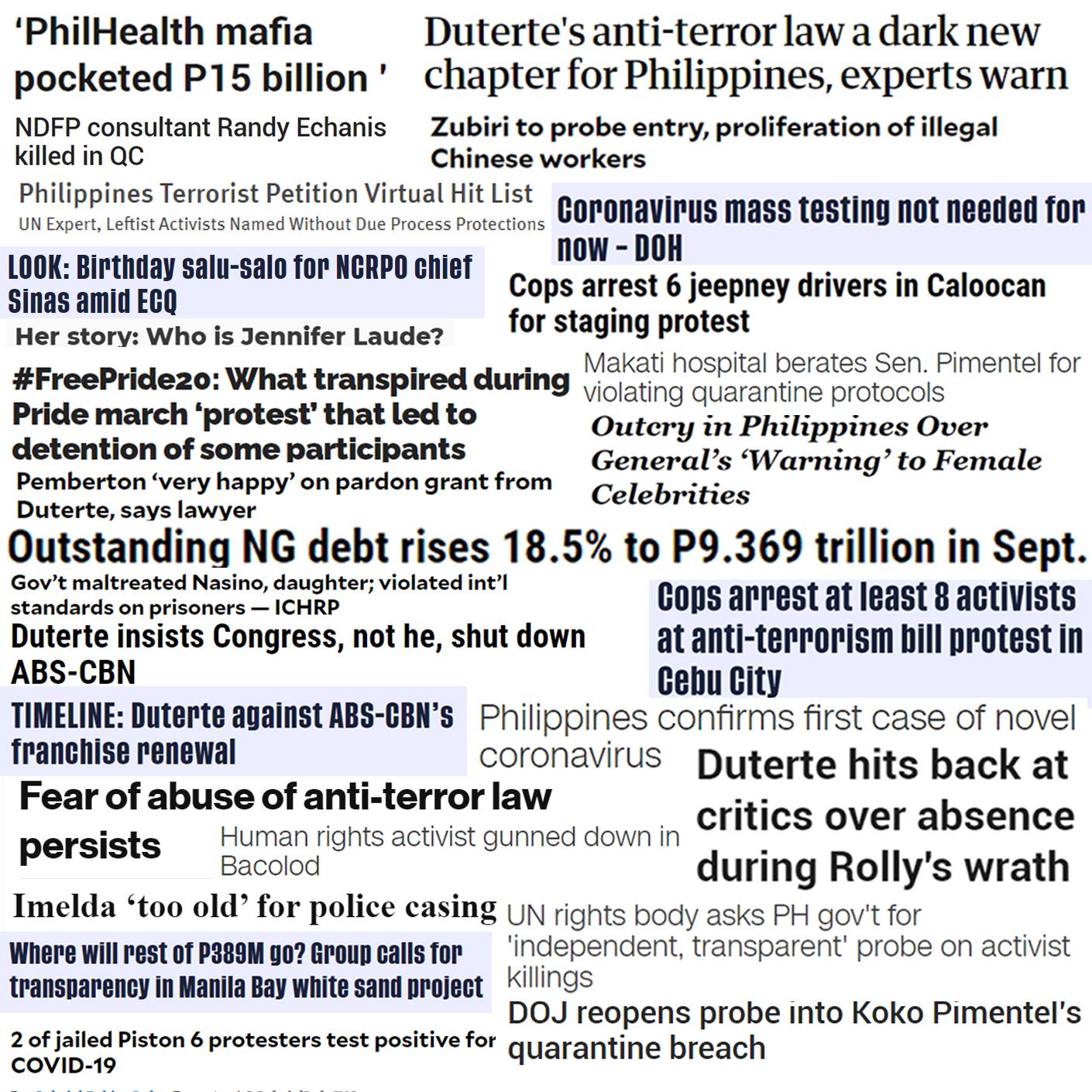True Philippine Horror Stories: 2020 Edition


American horror writer Stephen King once wrote, “Monsters are real. Ghosts are too. They live inside of us, and sometimes, they win.” This powerful statement from his critically acclaimed book The Shining serves as an important reminder that sometimes, real life — and real people — can be scarier than any ghost or creature of the night.
Halloween may be over, but that doesn’t mean there’s a lack of scary happenings in the everyday lives of Filipinos. The Red Circle has listed down its own version of true Philippine horror stories, from mysterious cases of missing government funds to double standards in the justice system:
No travel ban for China at the onset of COVID-19 outbreak in Wuhan
China experienced an outbreak of the mysterious pneumonia-like disease that we would later call COVID-19. Implementing a travel ban to and from China early would have been effective as the first outbreak in Wuhan was reported on December 31, 2019. The travel ban from Wuhan was only implemented on January 31, a day after the Philippines confirmed its first case of COVID-19.
Why it’s a horror story: The first local COVID-19 case was confirmed to be a 38-year-old female Chinese national who traveled from Wuhan via Hong Kong. She arrived in the Philippines on January 21, 2020. If a travel ban was implemented earlier, would our country’s health crisis look different today?
The lack of mass testing in the Philippines
No nation was ready for COVID-19, but two key practices have proven to be salient in fighting the spread of the virus: mass testing and aggressive contact tracing. Last March, early into the country’s battle with the pandemic, the Department of Health stated that there was no need yet for mass testing. It would then take weeks before the country began progressive mass testing.
Why it’s a horror story: The longer it took for Filipinos to be tested, the more likely it was for the disease to spread. Additionally, the nationwide lockdown imposed wasn’t maximized because of the lack of mass testing and aggressive contact tracing. This left many lost as to how to go about the pandemic, especially those whose livelihoods were affected. Fortunately, some LGUs like Mandaluyong, Taguig, Pasig, Cavite, and Manila did not wait for the national government to start their own mass testing. Once more tests were done later on, contract tracing and deciding which areas needed to be put under lockdown became easier.
Breaching of quarantine protocols
To help win the battle against COVID-19, very specific health measures are in place to prevent its spread. However, many were disturbed to hear about the then NCRPO Major General and recently appointed PNP Chief Debold Sinas’ mañanita during ECQ or Koko Pimentel’s visit to Makati Medical Center despite being a COVID-19 suspect, and later testing positive. Apart from them, the frustration is targeted at anyone who lacks the sense of urgency, accountability, and responsibility despite the lockdown.
Why it’s a horror story: Although the quarantine fatigue is real, people, especially leaders, who carelessly ignore health protocols (physical distancing, wearing of masks and face shields, ban on mass gatherings, etc.) not only put themselves and others at risk, but also set a bad example for others to follow. One wrong interaction with someone with COVID-19, or someone who has been exposed to the virus, almost immediately triggers a number of cases. The country may have adjusted to the new normal, but the virus is still very real. Safety should still be the top priority of Filipinos.
The Anti-terror Law
The controversial Anti-terror law has been talked about in both local and foreign media. In the middle of a pandemic where health and safety should be the top priorities, this bill became a law in just a matter of weeks. Furthermore, the Philippines’ Commission on Human Rights has stated that the broad definition of “terrorism” in the said law paves the road for possible abuse.
Why it’s a horror story: At a time when Filipinos are struggling to survive, the last thing they need is a law that can potentially be abused by those in power like baseless red-tagging, secret surveillance, and physical, moral, and psychological abuse of suspects among many others. Fighting terrorism is good, but this law can become dangerous when the definition of terrorism can be molded into something subjective.
Questionable arrests of Filipinos
The arrest of the Piston 6, the Cebu 8, and the Pride 20 all happened within a few months, even weeks of each other. While they were eventually released, the fact that they were all arrested raises questions on whether or not the justice system is selective of who they persecute. These individuals were arrested onsite, yet it took months for the DOJ to probe into Pimentel’s quarantine breach. Even Imelda Marcos being labeled as too old to go to jail is questionable when 72-year-old Elmer Cordero was put in one without hesitation.
Why it’s a horror story: The arrest of these groups and individuals during a pandemic puts their safety at risk, which was proven when two out of the six jeepney drivers arrested tested positive for COVID-19. It’s especially alarming that these arrests were done during peaceful protests, and despite protesters practicing physical distancing and following other health protocols. Furthermore, these arrests send an underlying message that using one’s voice to air out views and opinions may be met with dire consequences.
The Release of Joseph Scott Pemberton
Six years after the demise of transwoman Jennifer Laude, US Marine Joseph Scott Pemberton was granted absolute pardon by President Duterte, which came as a surprise to him and his lawyer. In 2015, Pemberton was convicted for the death of Laude and was sentenced to 12 years of imprisonment. After appealing to the courts, Pemberton was successful in lowering it down to 10 years.
Why it’s a horror story: Many considered the Laude slay case as a hate crime against the LGBT community and the conviction of Pemberton was a victory for them. Pemberton’s release unearthed the pains of the grieving Laude family, making it a true injustice not just for the LGBT community, but for the Filipino people. As a man may have walked free, has Laude’s murder really been given justice?
Killings of activists Randy Echanis and Zara Alvarez
Sometimes, standing up for something can cost a life. Take peasant leader and peace consultant Randy Echanis, who was tortured and killed in his home. Echanis served as the Anakpawis chairperson and Kilusang Magbubukid ng Pilipinas deputy secretary general. There’s also human rights leader and Negros Island Health Integrated Program (NIHIP) research and advocacy officer Zara Alvarez, who was gunned down in Bacolod.
Why it’s a horror story: The murder of activists Echanis and Alvarez were barely two weeks apart. They were both on the list of more than 600 people that the government labeled as members of the Communist Party of the Philippines (CPP) and its armed wing, the New People’s Army (NPA), and they were both mercilessly killed. The alarming rate of activist killings locally has also prompted the UN Humans Right Office to call for transparent and thorough investigations on these killings.
ABS-CBN Shutdown
Months into the pandemic, the government has had time to deny the franchise renewal of ABS-CBN, despite being in Congress for years. Was it really because of legal matters or was it politically motivated? President Duterte has denied having anything to do with the decision, but it’s also not a secret that he’s a critic of the network. Because of this shutdown, many Filipinos have lost their source of entertainment, news and advisories and are left in the dark as the series of storms continue to strike the country.
Why it’s a horror story: The shutdown of the country’s largest broadcasting network has left not only 11,000 employees jobless, but 11,000 families burdened with another problem on top of the ongoing pandemic. Apart from that, it’s also the ability and creativity of this government in using the law to get an upper hand on their critics. If they can do it to a broadcast giant like ABS-CBN, what’s stopping them from doing it to someone else?
Php 15B corruption within PhilHealth
PhilHealth is one of the mandatory contributions that are taken off from every Filipino’s salary not only because it’s a public contribution, but because it’s the government’s way of helping them with medical costs. In August, word got out that Php 15B worth of PhilHealth contributions from Filipinos is missing and remains to be up to this day.
Why it’s a horror story: These are hard-earned contributions of Filipinos and must therefore be used by Filipinos when the need comes. Instead of launching an investigation on PhilHealth from the onset, the government went ahead with putting dolomite sand to beautify Manila Bay, which is also a horror story of its own with Php 398M still in question.
Rising ‘COVID-19 Debt Toll’ in the Philippines
It’s an understatement to say that the Philippines was not financially ready to handle a pandemic. The country’s debt toll continues to rise following more local and foreign loans as part of the government’s COVID-19 response to help support both the Filipino people and the economy. As of the end of September, the total debt of the Philippines amounted to Php 9.369 trillion.
Why it’s a horror story: As the country goes deeper into debt, the interest and payment will likely extend to future generations of Filipinos. With a portion also attributed to loans from foreign entities, this will only be used as leverage to get more favors that would essentially put the country at a disadvantage, especially when it comes to business and trade deals in the future.
Honorable Mentions
Still wondering about stories that you should know about? Here are a few more so you see how the plot thickens.
- President Duterte’s absence during the crisis brought about by typhoon Rolly
- Entry of illegal Chinese workers in the Philippines
- Maltreatment of Reina Mae Masino as she grieved her Baby River
- Killing of Fabel Pineda and Winston Ragos
- Red-tagging of celebrities and Gabriela
The scariest thing about these stories is how real they are, and how some are irreversible events that will serve as tales of caution for those who may find themselves in similar situations. At the end of the day, it’s not about political color at all. It’s about what kind of nation we want, and what kind of society is best for the Filipino people. What we need is an environment that is safe, secure, and beneficial for all.
These stories should also be a wake up call for us Filipinos, that just because we don’t personally experience something doesn’t mean they don’t happen. After going through these scarier-than-fiction stories, one important question remains: What are you going to do about what you know now?
Read also:
Recent Posts
Reflections on AI in Education: A Path Forward
Last Friday, May 16, I attended the 16th Innotech International Conference of SEAMEO at the…
UNICEF, DBM & EU launch finance program for Filipino children
UNICEF, in partnership with the Department of Budget and Management and the European Union, announced…
‘My Dream in a Shoebox’ marks 16th year, celebrates support of partners
My Dream in a Shoebox (MDIAS), the annual advocacy campaign of award-winning strategic marketing agency…
Cloud-based AI prone to toxic combinations, leaves sensitive data vulnerable: report
Cloud and AI are undeniable game changers for businesses. However, both introduce complex cyber risks…
Timeline of The Punisher’s arrest: What happened and what comes next?
March 11, 2025 will be a day many will look back on. On that Tuesday,…
A first in PH: Agri company earns ‘reared without antibiotics’ certification
You’ve probably heard of poultry raised in stress-free environments, but have you heard of poultry…

